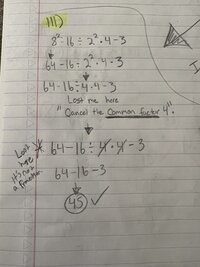Common factors? Simplify 8^2 - 16 ÷ 2^2 × 4 - 3
- Thread starter Squish93
- Start date
Otis
Elite Member
- Joined
- Apr 22, 2015
- Messages
- 4,592
Hi Squish. The Order of Operations tells us to do multiplication AND division in the order they appear, reading from left to right.I don’t understand why you would cancel both 4s on one side of the division sign.
16 ÷ 4 × 4
The division is done first, then the multiplication. In effect, the multiplication by 4 cancels out the division by 4, bringing us back to 16.
16 ÷ 4 = 4
4 × 4 = 16
Another way to look at it:
4116⋅141=16
Harry_the_cat
Elite Member
- Joined
- Mar 16, 2016
- Messages
- 3,782
The question states to simplify the expression, ...
Squish93, on your second line, you need to make your second subtraction line longer, because it started looking like a
multiplication dot.
I see you have no parenthetical/bracketed expressions.
All of your exponentiation should be taken care of in the same step. Then, multiplication/division will be done after that
from left to right, depending on which operation shows up first on the left. I will break down the last step of Harry_the_cat
into two steps, and I will use the "times" sign instead of a multiplication dot.
82−16÷22×4−3 =
64−16÷4×4−3 =
64−4×4−3 =
64−16−3 =
48−3 =
45
Steven G
Elite Member
- Joined
- Dec 30, 2014
- Messages
- 14,591
If you have 16÷4x4 you can do the multiplication 1st, ie do 16x4 and then do the division by 4.
I will say that the order of operations says to do the multiplication/division as they come up from left to right. This is not wrong but you can do whichever one you like 1st.
I will say that the order of operations says to do the multiplication/division as they come up from left to right. This is not wrong but you can do whichever one you like 1st.
Otis
Elite Member
- Joined
- Apr 22, 2015
- Messages
- 4,592
Indeed! I'd done so, myself, upon first recognizing those adjacent operations.do the multiplication/division as they come up from left to right. This is not wrong but you can do whichever one you like 1st
For other readers: When we view division by 4 to be the same as multiplication by ¼, then the Commutative Property of Multiplication tells us that we may multiply the three factors in any order we like. (The green version below is how I'd mentally parsed the 16÷4×4 chunk in the op image.)
(16)(¼)(4)
(16)(4)(¼)
(¼)(16)(4)
(¼)(4)(16)
(4)(16)(¼)
(4)(¼)(16)
Steven G
Elite Member
- Joined
- Dec 30, 2014
- Messages
- 14,591
Personally I like the last oneIndeed! I'd done so, myself, upon first recognizing those adjacent operations.
For other readers: When we view division by 4 to be the same as multiplication by ¼, then the Commutative Property of Multiplication tells us that we may multiply the three factors in any order we like. (The green version below is how I'd mentally parsed the 16÷4×4 chunk in the op image.)
(16)(¼)(4)
(16)(4)(¼)
(¼)(16)(4)
(¼)(4)(16)
(4)(16)(¼)
(4)(¼)(16)
I never did consider in this situation that dividing by m is the same as multiplying by 1/m. I just realized that when you have a string of just multiplication and division it just doesn't matter which you do first or 2nd or ...
Harry_the_cat
Elite Member
- Joined
- Mar 16, 2016
- Messages
- 3,782
Yeah you can, but you must apply the multiplication to the 16 not the 4, ie 16÷4×4=16×4÷4 NOT 16÷(4×4).If you have 16÷4x4 you can do the multiplication 1st, ie do 16x4 and then do the division by 4.
I will say that the order of operations says to do the multiplication/division as they come up from left to right. This is not wrong but you can do whichever one you like 1st.
I would be reluctant to say "you can do whichever one you like 1st" without further clarification.
Otis
Elite Member
- Joined
- Apr 22, 2015
- Messages
- 4,592
Oh, I misunderstood what you'd done (I'd thought you were mentally multiplying factors).I never did consider … dividing by m is the same as multiplying by 1/m

